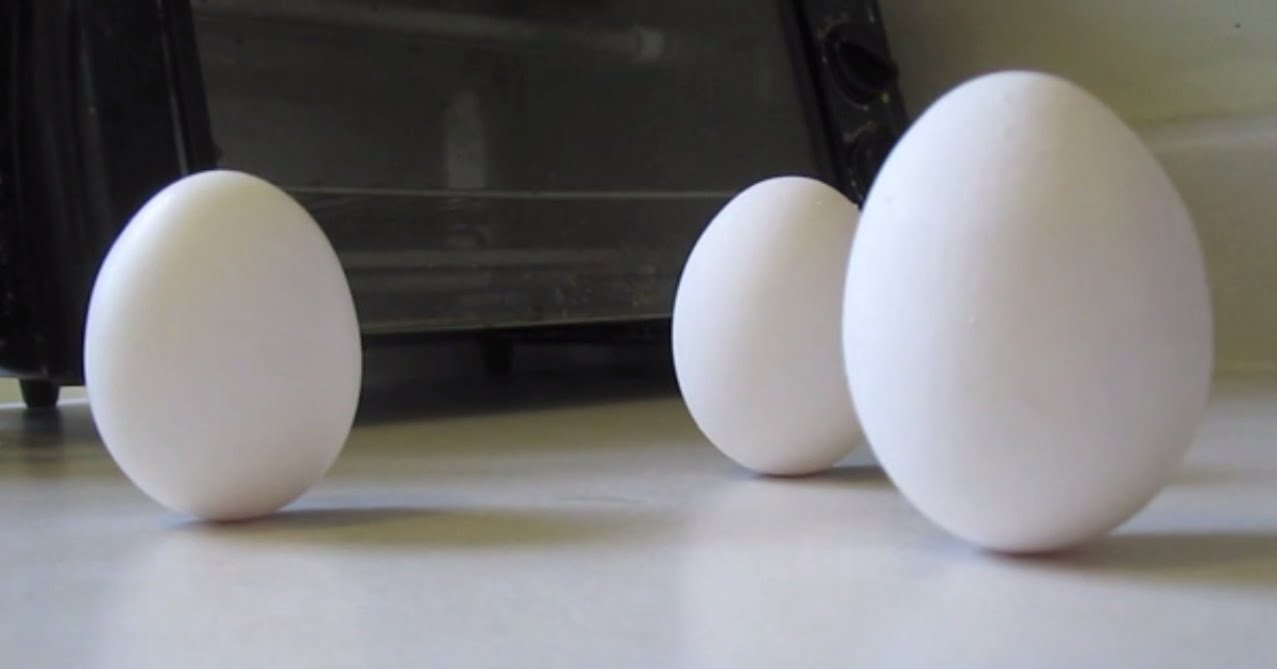It is believed that once a year, a raw chicken egg can be placed on the surface at one end so that it does not fall. We checked how correct this statement is.
Here's what information you can meet on the Internet with a link to the St. Petersburg Astrological Academy:
“There is a well-known story about Columbus’s egg, which tells that the great navigator won an argument by placing a raw egg on the blunt end. Some say that the egg was boiled and Columbus simply slightly crushed its blunt end. Others say that the table in the tavern was wooden, not very smooth, and the cunning Columbus found a hole in which he placed the egg. Still others question this fact altogether.
The truth is that a raw egg can be placed on its blunt end, and it will actually stand, but this can only be done once a year - on the day of the spring equinox. This simple experiment has been done by many. A raw egg sits on a flat surface for 24 hours. It can even be placed on a smooth glass surface, and it will stand for many hours until gravitational conditions change. The essence of this phenomenon is that on the days of the summer and winter solstices the Earth is turned towards the Sun by one of the poles and the Sun illuminates predominantly one of the hemispheres: either the Northern or the Southern. Along with lighting, the gravitational field of the Sun affects both hemispheres differently. On the days of the spring and autumn equinoxes, the Sun illuminates both hemispheres equally, and the gravitational field affects them evenly.
Therefore, on the day of the vernal equinox, unique gravitational conditions are created when the gravitational field acts evenly on both halves of a standing egg. On other days, this balance is disrupted, and the stability of the egg becomes impossible. This fact is based not on metaphysics, but on physics. During this period, the egg can be placed on its blunt end, and it can remain in an upright position for one or two days.”
The text is present on many sites, where answers to school problems are aggregated. However, the information indicated in it is popular in itself - for example, in Russia on March 20, people regularly conduct experiments with the laying of an egg, and in China, as the media write, this many centuries ago has become traditional game, accompanying the meeting of the Chongfen (spring equinox) season. The “equinox effect” is also known on West.
Let's leave aside the apocryphal story of Columbus's egg, which, according to popular belief, hypothesis, an Italian historian could have come up with Girolamo Benzoni in 1565. Let's turn to physics.
Firstly, it is not clear why the popular text speaks of “the only time in the year”, if the conditions immediately describe the possibility of a similar effect in autumn equinox - September 22 (sometimes 23). From an astronomical point of view, this day is no different from March 20, being its analogue for the Southern Hemisphere, where spring, as is known, comes with a six-month shift. Nevertheless, the legend is about the March balancing of eggs popular in Australia and New Zealand, which already raises some doubts about its truth.
Secondly, let's consider the very concept of seasons. Their existence is associated with the inclination of the Earth's rotation axis relative to the plane of its orbit. When the earth's axis on the side of the nearest pole is tilted towards the Sun, it will be summer in that hemisphere. When the axis points in the other direction - winter. The days of the spring and autumn equinox mark the time when the earth's axis is located strictly perpendicular to the lines connecting the center of the Sun and the Earth.

What does this mean in practice? How notes American astronomer and science popularizer Phil Plate (The Bad Astronomer), this just means that the length of day and night on a given day will be almost the same: about 12 hours each. In other words, it will not affect us here on the surface of the planet. If we were locked in a room without windows, there would be no way for us to determine that it was the vernal equinox—gravity remained the same. The gravitational and electromagnetic forces created by other celestial bodies are much weaker and more stable than the disturbances created by human breathing and heartbeat.
As it turns out, the popularity of the legend of spring egg balancing in the West is associated with the publication on March 19, 1945 in the American magazine Life articles entitled “Eggs Stand Upright in Chongqing.” It was dedicated to the craze of the population of the temporary capital of China for this fun on the holiday of the arrival of spring Lichun, which is celebrated on February 4–5, and not at all on March 20.
As the article stated, on this February day, most of the population of Chongqing is busy balancing eggs. These items can be seen everywhere: on lawns, tables and other surfaces. According to the legend, which the article traced back to two ancient Chinese books (their names are unknown to search engines), for two hours at the turn of winter and spring the egg should miraculously stand upright. And in February 1945, after news of another such holiday, Albert Einstein himself allegedly expressed doubt that such an effect was achievable. Having learned about this, the indignant residents of the city gathered and took a photograph with the newly installed eggs. At first, they were even allegedly going to put the inscription “Einstein is crazy” on them:

The publication in Life caused a stir in the United States and attempts to repeat the success of the Asians, but not on Lichun, which is alien to the Western world, but on the more familiar and rather symbolic day of the spring equinox. The mania peaked nearly 40 years later in Manhattan. According to article in The New Yorker, in March 1983, one Donna Henes organized her sixth annual egg balancing ceremony to promote harmony on earth. The event was marked by the firing at the appointed hour of 52 emergency flares, one for each week of the year. While the rockets were burning, Henes distributed 360 raw eggs to those around her. Why 360? Because, as Henes explained, the circumference of the Earth is 360°.
In 1947, after the Chinese tradition was written about in Japan, local physicist Ukichiro Nakaya experimentally provedthat the egg can be placed vertically at any time of the year. He noticed that the egg shell usually has many small tubercles and dimples. In this case, it is not difficult to find a position such that the center of mass of the egg is inside the triangle formed by the three points of contact with the surface, which is a condition for balancing any object. His discovery was confirmed astronomer Frank Guigo in 1984. The latter, for more than a month, from February 27 to April 3, tried every day to place 12 eggs on a plastic table, and over time his results improved purely due to the acquisition of experience. Moreover, the day of the vernal equinox turned out to be almost the most unlucky for the experimenter, which the latter associated with too late a time for the experiment - 4:24 a.m., as required by the astronomical calendar.
Everything worked out for his colleague Phil Plait on October 25, 1998:

There is, of course, a simpler, but fraudulent way - to add a little salt under the egg, which will allow the item to balance between several almost imperceptible crystals. However, even without this, we can confidently say that egg balancing is quite real and does not depend on the day or time of year.
Not true
Read on the topic:
1. Eggs Stand on End in Chungking. Life, March 19, 1945.
2. Martin Gardner. The great egg-balancing mystery — the tricks behind making an egg stand on its broad end,
3. Phil Plait's Bad Astronomy. Misconceptions
4. Equinox Returns and Eggs Keep Balancing.
If you find a spelling or grammatical error, please let us know by highlighting the error text and clicking Ctrl+Enter.







